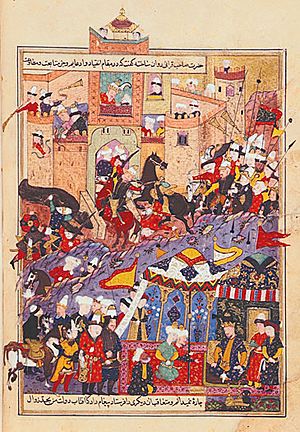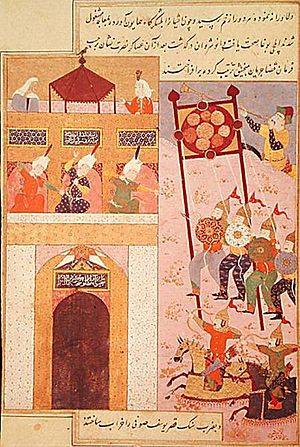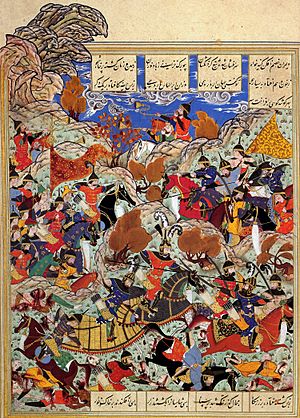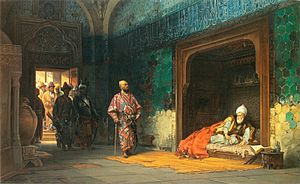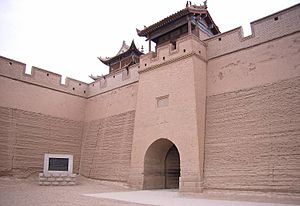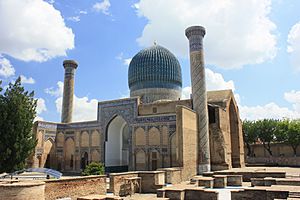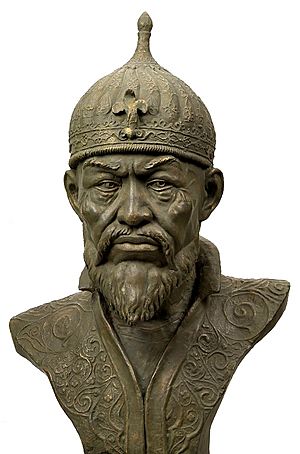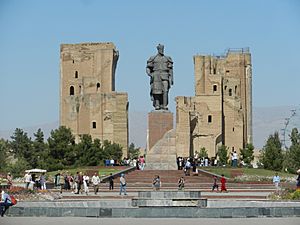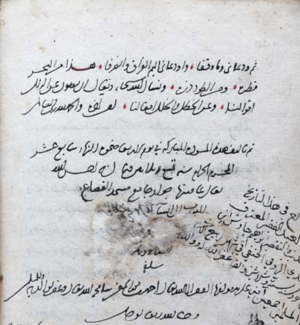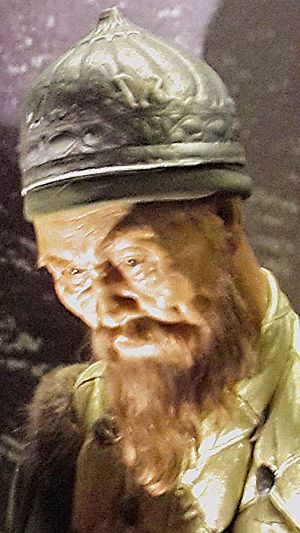Timur facts for kids
Quick facts for kids Timur |
|||||
|---|---|---|---|---|---|
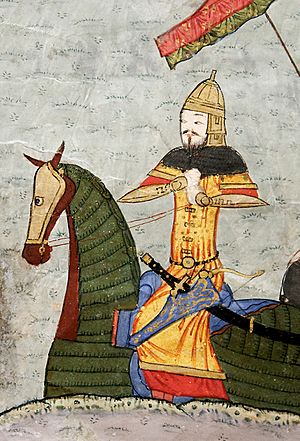
Timur leading his troops at the 1393 Conquest of Baghdad. Near-contemporary portrait in Zafarnama, commissioned by his grandson Ibrahim Sultan in 1424–28. Published in 1435-36.
|
|||||
| Amir of the Timurid Empire | |||||
| Reign | 9 April 1370 – 14 February 1405 |
||||
| Coronation | 9 April 1370, Balkh | ||||
| Successor | Khalil Sultan | ||||
| Born | 9 April 1336 near Kesh, Chagatai Khanate |
||||
| Died | 18 February 1405 (aged 68) Farab, Timurid Empire |
||||
| Burial | Gur-e-Amir, Samarkand, Uzbekistan | ||||
| Consort | Saray Mulk Khanum | ||||
| Wives |
|
||||
| Issue Detail |
|
||||
|
|||||
| Dynasty | Timurid | ||||
| Father | Amir Taraghai | ||||
| Mother | Tekina Khatun | ||||
| Religion | Sunni Islam | ||||
Timur (born April 9, 1336 – died February 17, 1405) was a powerful leader and conqueror from Central Asia. He founded the Timurid Empire, which covered areas like modern-day Afghanistan, Iran, and Central Asia. People often remember him as one of the greatest military commanders in history. He was also known for being very harsh.
Timur was a big supporter of art and building. His rule led to a period called the Timurid Renaissance, where many smart people like Ibn Khaldun and Hafez were active.
He was born in a region called Transoxiana, which is now part of Uzbekistan. By 1370, he had taken control of the western part of the Chagatai Khanate. From there, he led many military campaigns across Asia and parts of Europe. He defeated powerful groups like the Golden Horde, the Mamluks, and the Ottoman Empire. This made him the most powerful ruler in the Islamic world. His empire, however, broke apart soon after he died.
Timur was the last of the great nomadic conquerors. His empire helped set the stage for the rise of later powerful empires like the Islamic gunpowder empires. He had both Turkic and Mongol family roots. He often tried to connect himself to the famous conqueror Genghis Khan. Timur also used Islamic ideas to make his rule seem right, calling himself the "Sword of Islam." He supported schools and religious places.
His armies were made up of many different groups of people. They were feared across Asia, Africa, and Europe. Historians believe his wars caused the deaths of millions of people. Timur was the grandfather of Ulugh Beg, a famous astronomer, and the great-great-great-grandfather of Babur, who founded the Mughal Empire in India.
Contents
- Early Life
- Becoming a Leader
- Rise to Power
- How Timur Justified His Rule
- Expanding the Empire
- Conquering Persia
- Wars with Tokhtamysh
- Campaigns in India
- Campaigns in the Levant
- Invasion of Anatolia
- Plans to Attack the Ming Dynasty
- Death
- Who Ruled After Timur?
- Family and Descendants
- Personality and Views
- Connections with Europe
- Legacy
- Historical Sources
- Exhumation and a Legend
- Timur in Arts and Games
- Images for kids
- See also
Early Life
Timur was born near the city of Kesh, which is now called Shahrisabz in Uzbekistan. This city is about 80 kilometers south of Samarkand. His name Temur means "Iron" in his native language. It's similar to Genghis Khan's birth name, Temüjin.
He belonged to the Barlas tribe, a Mongol group that had adopted many Turkic customs. His father, Taraghai, was a respected and wealthy noble. Some historians think Timur might have made his father's position seem less important later on. This would make Timur's own rise to power seem even more amazing.
When he was young, Timur and his small group of friends would raid travelers for things like sheep, horses, and cattle. Around 1363, he was shot by two arrows while trying to steal a sheep. One arrow hit his right leg, and another hit his right hand, causing him to lose two fingers. These injuries left him with a limp for life. This is why Europeans sometimes called him "Timur the Lame" or "Tamerlane."
Becoming a Leader
By 1360, Timur had become a well-known military leader. His soldiers were mostly Turkic tribesmen. He joined campaigns in Transoxiana with the Khan of the Chagatai Khanate. He even allied with Qazaghan, who had overthrown a ruler. Timur led a thousand horsemen to invade Khorasan, a region in Persia. This successful mission led to more conquests, including taking over Khwarazm and Urgench.
After Qazaghan was killed, many people fought for power. Tughlugh Timur, the Khan of the Eastern Chagatai Khanate, invaded. Timur was sent to talk with the invader but instead joined him. As a reward, Timur was given control of Transoxania. Around this time, his father died, and Timur also became the chief of the Barlas tribe.
Rise to Power
During this time, Timur made the Chagatai Khans into puppet rulers. This meant they were still called "Khans," but Timur was the one truly in charge. Timur and his brother-in-law, Amir Husayn, were once friends. But they became rivals. Their relationship got worse after Husayn didn't follow Timur's orders.
Timur gained many supporters in Balkh, including merchants, fellow tribesmen, religious leaders, and farmers. He was kind and shared his wealth with them. This was different from Husayn, who took a lot of money from people through high taxes and spent it on fancy buildings. Around 1370, Husayn gave up to Timur. Husayn was later killed. This allowed Timur to officially become the ruler in Balkh. He married Husayn's wife, Saray Mulk Khanum, who was a descendant of Genghis Khan. This marriage helped Timur claim to be a royal ruler.
How Timur Justified His Rule
Timur's background gave him both chances and challenges in ruling the Mongol Empire and the Muslim world. According to Mongol traditions, Timur couldn't be called a khan because he wasn't a direct descendant of Genghis Khan. So, Timur put a puppet Khan named Suyurghatmish in charge of Balkh. Timur pretended to be a "protector" of the Genghis Khan family line.
Instead, Timur used the title of Emir, which means general. He acted as if he was ruling on behalf of the Chagatai ruler of Transoxania. To make his position stronger, Timur claimed the title Guregen, meaning "royal son-in-law," when he married Saray Mulk Khanum. She was a princess from Genghis Khan's family.
Timur also couldn't claim the highest title in the Islamic world, Caliph. This title was only for people from the Quraysh tribe, the tribe of the Prophet Muhammad. So, Timur created a story that he had "supernatural power" given by God. He also said he was a spiritual descendant of Ali, a key figure in Islam. This way, he tried to connect himself to both Genghis Khan and the Prophet Muhammad's family.
Expanding the Empire
Timur spent the next 35 years fighting wars and leading expeditions. He made his rule strong at home by defeating his enemies. He also expanded his territory by taking lands from other rulers. His conquests to the west and northwest reached the areas near the Caspian Sea and the Ural and Volga rivers. In the south and southwest, he conquered almost all of Persia, including Baghdad and Northern Iraq.
One of Timur's toughest enemies was another Mongol ruler named Tokhtamysh. Tokhtamysh was a descendant of Genghis Khan. He had once been a refugee in Timur's court but later became the ruler of the Golden Horde. After gaining power, he fought with Timur over control of Khwarizm and Azerbaijan. However, Timur still helped him against the Russians. In 1382, Tokhtamysh invaded Russia and burned Moscow.
Later, in 1395, Timur's armies reached the border of Russia. They took the city of Elets and started moving towards Moscow. But suddenly, Timur's armies retreated. Many Russians believed this was a miracle.
Conquering Persia
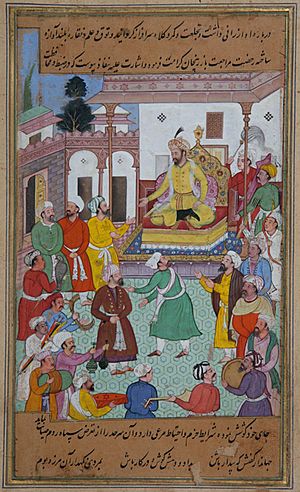
After the ruler of the Ilkhanate, Abu Sa'id, died in 1335, Persia was divided among many different groups. In 1383, Timur began his long military conquest of Persia. He already controlled much of Khorasan by 1381.
Timur started his Persian campaign with Herat, the capital of the Kartid dynasty. When Herat refused to surrender, he destroyed the city and killed most of its people. The city remained in ruins for many years. Timur then sent a general to capture rebellious Kandahar. After Herat was captured, the Kartid kingdom gave up and became Timur's vassals.
Timur then moved west to the Zagros Mountains. He captured the town of Tehran, which surrendered and was treated kindly. He also attacked Soltaniyeh in 1384. A year later, Khorasan rebelled. Timur destroyed Isfizar and had prisoners cemented into the walls alive. The next year, the kingdom of Sistan was ruined, and its capital, Zaranj, was destroyed.
Timur returned to his capital, Samarkand, to plan his campaigns against Georgia and the Golden Horde. When he came back to Persia, he found that his generals had protected the lands he had conquered. Even though many areas rebelled, Timur still held control. He then went on to capture the major southern cities of Isfahan and Shiraz.
When he arrived at Isfahan in 1387, the city quickly surrendered. He treated it with mercy, as he usually did with cities that gave up. However, Isfahan rebelled against Timur's taxes, killing tax collectors and some of his soldiers. In response, Timur ordered a massacre of the city's people. Between 100,000 and 200,000 people were killed. But he spared artists and educated people.
Timur then began a five-year campaign to the west in 1392. He attacked Persian Kurdistan. In 1393, Shiraz was captured after surrendering. The Muzaffarids became Timur's vassals, but when Prince Shah Mansur rebelled, he was defeated, and the Muzafarids were fully taken over. Soon after, Georgia was devastated so the Golden Horde couldn't use it to threaten northern Iran. In the same year, Timur surprised Baghdad by marching there in just eight days from Shiraz.
Wars with Tokhtamysh
Tokhtamysh, the Khan of the Golden Horde, turned against Timur in 1385 and invaded Azerbaijan. Timur responded, leading to the Tokhtamysh–Timur war. In the first battle, Timur won, but Tokhtamysh and some of his army escaped. After this defeat, Timur invaded Russia, north of Tokhtamysh's lands. Timur's army burned Ryazan and moved towards Moscow. But he was pulled away by Tokhtamysh's new campaign in the south.
In the first part of the conflict, Timur led an army of over 100,000 men far north into the steppe. His army went so far north that they were in a region with very long summer days. This caused his Muslim soldiers to complain about their long prayer schedule. Timur's army trapped Tokhtamysh's army against the Volga River and destroyed them in 1391.
In the second part of the conflict, Timur took a different route, invading Tokhtamysh's lands through the Caucasus region. In 1395, Timur defeated Tokhtamysh in the Battle of the Terek River. This ended the fight between the two rulers. Tokhtamysh never regained his power and was killed about ten years later. During Timur's campaigns, his army destroyed Sarai, the capital of the Golden Horde, and Astrakhan. This greatly weakened the Golden Horde.
Campaigns in India
In 1398, Timur invaded northern India, attacking the Delhi Sultanate. This was ruled by Sultan Nasir-ud-Din Mahmud Shah Tughluq. After crossing the Indus River on September 30, 1398, he attacked Tulamba and killed its people. He then captured Multan by October. Most Indian nobles gave up without a fight. However, he faced resistance from a combined army of Rajputs and Muslims at Bhatner. The city was looted and burned.
As he marched towards Delhi, Timur was attacked by Jat farmers. They would rob his caravans and then hide in the forests. Timur had 2,000 Jats killed. The Sultanate in Delhi did nothing to stop his advance.
Capturing Delhi (1398)
The main battle took place on December 17, 1398. Before the fight, Timur killed about 100,000 slaves he had captured. He was afraid they might rebel during the battle.
Sultan Nasir-ud-Din Mahmud Shah Tughluq's army had war elephants. These elephants were covered in armor and had poison on their tusks. Timur's soldiers were scared of the elephants. So, Timur ordered his men to dig a trench in front of their positions. Then, Timur loaded his camels with wood and hay. When the war elephants charged, Timur set the hay on fire and poked the camels with iron sticks. The camels, howling in pain, charged at the elephants. Timur knew that elephants could be easily scared. When the elephants saw the camels charging with flames on their backs, they turned around and ran back into their own lines. Timur used this confusion to win an easy victory. The Sultan fled with the rest of his army.
Taking over the Delhi Sultanate was one of Timur’s biggest and most destructive victories. At that time, Delhi was one of the richest cities in the world. The city was looted and destroyed, and its people were enslaved. After the city fell, its citizens rebelled against Timur's forces. This led to a bloody massacre inside the city walls. Timur's invasion left Delhi in ruins. The city did not recover for almost a century.
Campaigns in the Levant
Before the end of 1399, Timur started a war with Bayezid I, the sultan of the Ottoman Empire, and the Mamluk sultan of Egypt, Nasir-ad-Din Faraj. Bayezid had been taking over lands from Turkic and Muslim rulers in Anatolia. Since Timur claimed to be in charge of these Turkoman rulers, they sought his protection.
In 1400, Timur invaded Armenia and Georgia. More than 60,000 people were captured as slaves, and many areas became empty. He also attacked Sivas in Anatolia.
Then Timur turned his attention to Syria. He attacked Aleppo and Damascus. The people of these cities were killed, except for the skilled workers, who were sent to Samarkand.
Timur invaded Baghdad in June 1401. After capturing the city, 20,000 of its citizens were killed.
Invasion of Anatolia
For years, Timur and Bayezid had sent insulting letters to each other. Timur tried to make Bayezid seem like a weak ruler.
Finally, Timur invaded Anatolia and defeated Bayezid in the Battle of Ankara on July 20, 1402. Bayezid was captured and later died while imprisoned. This started a twelve-year period of confusion in the Ottoman Empire. Timur said he attacked Bayezid to bring back the power of the Seljuks. He saw the Seljuks as the rightful rulers of Anatolia because Mongol conquerors had given them power. This shows again how much Timur cared about being seen as a true heir to Genghis Khan's legacy.
In December 1402, Timur attacked and took the city of Smyrna. This city was a stronghold of the Christian Knights Hospitaller. After this victory, Timur called himself a ghazi, meaning "Warrior of Islam."
Timur was angry with the Genoese and Venetians. Their ships had helped the Ottoman army escape to safety in Thrace.
While Timur was still in Anatolia, Qara Yusuf attacked and captured Baghdad in 1402. Timur returned to Persia and sent his grandson, Abu Bakr ibn Miran Shah, to take Baghdad back, which he did. Timur then spent some time in Ardabil. After that, he marched to Khorasan and then to Samarkand. He spent nine months celebrating and getting ready to invade Mongolia and China.
Plans to Attack the Ming Dynasty
By 1368, Chinese forces had driven the Mongols out of China. The first emperors of the new Ming dynasty made many Central Asian countries into states that paid tribute to them. The Ming Empire and Timur's empire had a long-standing relationship where one was supposed to be superior to the other. In 1394, the Ming emperor sent a letter to Timur, calling him a subject. Timur had the ambassadors arrested. Later ambassadors from the Ming Empire also faced similar treatment.
Timur eventually planned to invade China. To do this, he made an alliance with the remaining Mongol tribes in Mongolia. He prepared his army all the way to Bukhara.
Death
Timur usually preferred to fight his battles in the spring. However, he died during an unusual winter campaign. In December 1404, Timur began military campaigns against Ming China. He became sick while camped near the Syr Daria river and died at Farab on February 17, 1405. He never reached the Chinese border. After his death, the Ming ambassadors were released by his grandson, Khalil Sultan.
Timur's body was embalmed and placed in an ebony coffin. It was then sent to Samarkand, where he was buried. His tomb, the Gur-e-Amir, can still be seen in Samarkand today.
Who Ruled After Timur?
Timur had chosen heirs twice before, but they both died before him. His son, Jahangir, died in 1376. His grandson, Muhammad Sultan, died from battle wounds in 1403. After Muhammad Sultan's death, Timur didn't name a new heir for a while. Only when he was dying did he choose Muhammad Sultan's younger brother, Pir Muhammad, to take his place.
Pir Muhammad couldn't get enough support from his relatives. A difficult civil war broke out among Timur's descendants, with many princes trying to claim the throne. It wasn't until 1409 that Timur's youngest son, Shah Rukh, was able to defeat his rivals and become Timur's successor.
Family and Descendants
Timur had many wives and concubines, about forty-three in total. He often married women from the lands he conquered.

Sons of Timur
- Umar Shaikh Mirza I
- Jahangir Mirza
- Miran Shah Mirza
- Shah Rukh Mirza
Daughters of Timur
- Aka Begi (died 1382)
- Sultan Bakht Begum (died 1429/30)
- Sa'adat Sultan
- Bikijan
- Qutlugh Sultan Agha
Famous Descendants
- Mirza Muhammad Taraghay – also known as Ulugh Beg, a famous astronomer.
- Zahir-ud-din Muhammad Babur – founder of the Mughal Empire in India.
Personality and Views
Timur was seen as a brilliant military leader and a smart planner. He was very good at keeping the loyalty of nomadic groups in Central Asia. He was also very intelligent. Timur learned Persian, Mongolian, and Turkic languages. Persian was the main language used in his court and government.
Historians say Timur was "a product of an Islamized and Iranized society." He often used either Islamic religion or Mongol laws to achieve his military goals or political aims. Timur enjoyed the company of scholars and was kind to them.
There's a famous story about Timur meeting the Persian poet Hafez. Timur was upset because Hafez wrote a poem saying he would give the cities of Samarkand and Bukhara for a mole on someone's cheek. Timur said, "I have conquered most of the world to make Samarkand and Bukhara great cities, and you would trade them for a mole?" Hafez cleverly replied, "It is by such generosity that I have become poor." Timur was pleased with the witty answer and gave the poet gifts.
Many believe Timur's main reason for his campaigns was his ambition to rule. He once said, "The whole world is not big enough for two kings." However, outside of Iran, Timur often just plundered the lands he invaded to enrich his capital, Samarkand. He didn't always focus on governing the conquered areas, which might be why his empire broke apart quickly after his death.
Timur often used Persian sayings in his conversations. His motto was the Persian phrase rāstī rustī, meaning "truth is safety." He is also credited with inventing a chess game called Tamerlane chess.
Connections with Europe
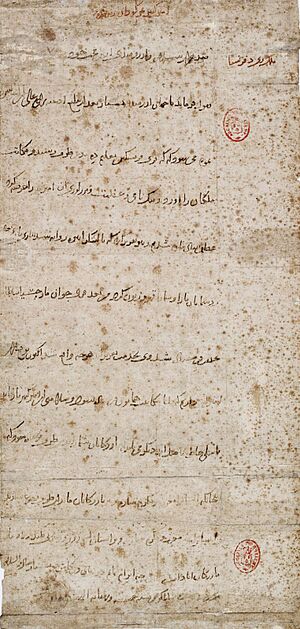
Timur had many letters and diplomatic exchanges with European countries, especially Spain and France. In 1402, during the Battle of Ankara, two Spanish ambassadors were already with Timur. Later, Timur sent an ambassador to the court of the King of Castile with letters and gifts.
In return, King Henry III of Castile sent a famous group of ambassadors to Timur's court in Samarkand from 1403 to 1406. When they returned, Timur said he thought of the King of Castile "as his very own son."
The French archives have a letter from Timur to Charles VI of France, dated July 30, 1402. In it, Timur suggests that France send traders to Asia. There's also a Latin copy of a letter from Timur to Charles VI in May 1403, and another from his son, Miran Shah, announcing their victory over Bayezid I.
Legacy
Timur's legacy is a mix of good and bad. While Central Asia thrived under his rule, other places like Baghdad, Damascus, Delhi, and other cities in Arab lands, Georgia, Persia, and India were attacked and destroyed. Their people suffered greatly. So, while Timur is seen as a hero in Muslim Central Asia, many people in Arabia, Iraq, Iran, and India remember him for his harsh actions.
However, the historian Ibn Khaldun praised Timur for uniting much of the Muslim world when other conquerors couldn't. The next great conqueror of the Middle East, Nader Shah, was greatly influenced by Timur. He almost repeated Timur's conquests and battle strategies in his own wars.
Timur's empire also blended Turkic and Persian cultures in Transoxiana. In most of the lands he took over, Persian became the main language for government and literature. Turkic languages also grew in importance and became official languages alongside Persian.
Timur's actions almost completely wiped out the Church of the East, a major branch of Christianity at the time.
Today, Timur is officially recognized as a national hero in Uzbekistan. His statue in Tashkent now stands where a statue of Karl Marx once was.
Historical Sources
The earliest known history of Timur's rule was the Zafarnama by Nizam al-Din Shami. It was written while Timur was still alive. Later, between 1424 and 1428, Sharaf ad-Din Ali Yazdi wrote a second Zafarnama, using much of Shami's work. Ahmad ibn Arabshah wrote a less positive history in Arabic.
The two Zafarnama books, which were supported by Timur's family, show a very different picture of him compared to Arabshah's book. William Jones noted that the Zafarnama books showed Timur as a "generous, kind, and famous prince." But Arabshah described him as "deformed and unholy, of low birth and terrible principles."
Exhumation and a Legend
Timur's body was removed from his tomb on June 19, 1941. His remains were studied by Soviet scientists. They reconstructed Timur's face from his skull. They found that he had "typical Mongoloid features," which means East Asian features in modern terms. Studies of his skull showed he was mostly of the South Siberian Mongoloid type. At 5 feet 8 inches, Timur was tall for his time. The studies confirmed that Timur had a limp and a weak right arm due to his injuries. His right thighbone had joined with his kneecap, meaning his leg was always bent, causing a noticeable limp. He had a broad chest, and his hair and beard were red.
It is said that Timur's tomb had the words, "When I rise from the dead, the world shall tremble." It is also said that when his body was dug up, another message was found inside the coffin: "Whosoever opens my tomb shall unleash an invader more terrible than I." Even though some people close to the scientists say this story isn't true, the legend continues. Three days after Timur's body was exhumed, Adolf Hitler invaded the Soviet Union. Timur was re-buried with full Islamic ceremony in November 1942, just before the Soviet victory at the Battle of Stalingrad.
Timur in Arts and Games
- Tamburlaine the Great, Parts I and II (English, 1563–1594): a play by Christopher Marlowe.
- Tamerlano (1724): an opera by George Frideric Handel.
- Tamerlane (published 1827): the first published poem by Edgar Allan Poe.
- Turandot (1924): an opera by Giacomo Puccini, where Timur is a blind, former king.
- Age of Empires II: Definitive Edition (2019): a video game with a campaign called "Tamerlane."
Images for kids
See also
 In Spanish: Tamerlán para niños
In Spanish: Tamerlán para niños


